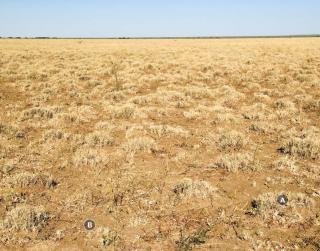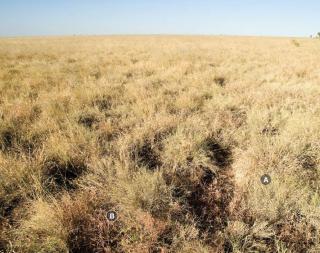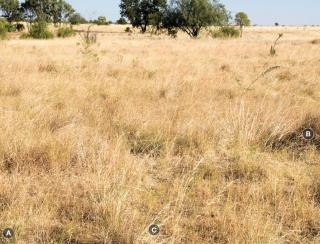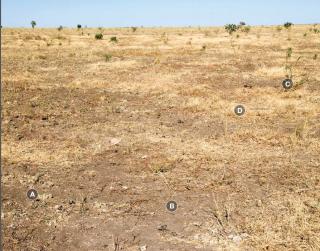Mitchell grass alluvial plain pastures
These pastures are part of the Kimberley 'black' soils group of pastures, and the perennial Mitchell grasses are the identifier grasses. Use the interactive key to pasture condition to help identify pasture type.
Pastoral value
Productive and resilient under grazing, good condition pastures dominated by Mitchell grass have high pastoral value. As Mitchell grass density declines, pastoral value falls because less productive perennial grasses (those with reduced pasture bulk and resilience) or undesirable species, like feathertop, take over. Red Flinders grass provides good feed for livestock, particularly early in the year, but its bulk depends on the season. In below-average rainfall years, minimal red Flinders grass may be produced.
Occurrence
Mitchell grass alluvial plain pastures are tussock grasslands that occur on level plains with gilgai microrelief. Gilgai (crabhole country) has a markedly undulating surface caused by swelling and shrinking of the clay soil during alternating wet and dry seasons. There are sometimes scattered small trees, such as bauhinias, in these pastures.
Pasture condition
Good: Desirable Mitchell grasses (barley and/or hoop Mitchell) usually dominate in good pasture condition, often with small amounts of other desirable perennial grasses, such as bundle-bundle and ribbon grass. Mitchell grass tussocks are healthy and evenly spaced (Figures 1 and 2).
Annual grasses, such as red Flinders grass and Kimberley couch, and herbs may occupy the spaces between perennial tussocks early in the year. As the dry season progresses, the groundcover between Mitchell grass tussocks is reduced as annual grasses are grazed.


Fair: Density and vigour of desirable Mitchell grasses and other desirable perennial grasses fall as pasture condition declines from good to fair. Bull Mitchell grass is considered an intermediate grass in this pasture type, and it or other intermediate species, such as native millet, may become prominent (Figure 3).
Feathertop, an undesirable perennial threeawn, may increase. Red Flinders grass or less-desirable annual plants may occupy the increased space between perennial grass tussocks.

Poor: Further deterioration to poor condition results in almost complete loss of the Mitchell grasses and other desirable species, and a significant increase in bare ground. Two things may happen: the pasture may be dominated by non-grass plants (woody and/or weedy species); or the pasture may be completely dominated by feathertop. Both situations are unproductive (Figure 4).

Associated plants
| Common name (link to DPIRD species page) | Scientific name (link to FloraBase) | Life form |
|---|---|---|
| Desirable species | ||
| perennial | ||
| perennial | ||
| perennial | ||
| perennial | ||
| Queensland bluegrass | annual or short-lived perennial | |
| Intermediate species | ||
| perennial | ||
| perennial | ||
| perennial | ||
| Red Flinders grass | annual | |
| annual | ||
| annual | ||
| Kimberley couch | annual | |
| Ray grass | perennial | |
| Sensitive plants | Neptunia spp. | perennial |
| Undesirable species | ||
| perennial | ||
| Speedy weed | annual | |
| Goathead burr | annual or short-lived perennial | |
| Yellow daisy | annual |

